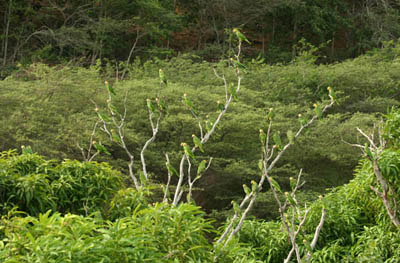Wow! Well that was certainly a whirlwind trip to Bonaire. The count preparations went extremely well, as did the count itself. The result: the yellow-shouldered Amazon parrot population on Bonaire has around 650 individuals. That’s a good few more than I expected but of course it is good news. I was out every morning and night prior to the big day and the numbers the volunteers came back with on the day of the count matched my own feeling for those sites so I am happy with the accuracy of the result.
In the run up to the count, between the dawn and dusk roost watches I was busy with a whole load of stuff other stuff. We got the parrots in the newspaper for four weeks running. I got on the radio twice and I got involved with Salbas Nos Lora (Save the lora) the group organising the count. We were all keen to try and improve the accuracy of the count and we put together a presentation, which was used at two volunteer training events. We also tweaked the methodology to reduce recounting, for example we decided to get observers to synchronise watches so we could track groups of parrots, in the observer’s notes, if they moved out of one roost into another.
The count itself takes place on a Saturday morning and volunteers station themselves at the known roost sites before dawn. They then work in pairs to count the number of birds leaving each roost. There may be more than one team at a site and we can compare their results. It was organised so that the busiest sites had at least two pairs of observers. There’s more information about the count in my (soon to come out) Psittascene article.
After the count I was busy making preparations for the coming season, organising transport and accommodation for Rowan and I, as well as for the many volunteers that will be donating their time to the project. I also wanted to repair some former parrot nests that had been damaged by poachers. That went well. Improving safety and access to the infamous overhang nest however took a lot of time and didn’t really result in what I had aimed for. I was trying to place climbing bolts in the rock but drilling the rock took a lot of work. The cordless drill generously lent to me was not up to it. So I ended up borrowing a generator and carrying that under the cliffs (no path!) along with a drill, electrical transforer and all the climbing gear. Even then it wasn’t simple, I’d be drilling away and then the generator, with it’s leaky tank would run out of fuel and die. On my second day of trying, having been on the ropes for a couple of hours I reluctantly accepted I needed to return with the right equipment to achieve what I wanted to.

































